Pawscessories is reader-supported. When you buy via links on our site, we may earn an affiliate commission at no cost to you.
Learn more.
The Exotic Bully is a relatively new dog breed that is slowly gaining popularity all over the world.
They are cousins to the American Bully, but with their unique features and traits, they are quickly becoming one of the most popular bully dogs in the world.
Dog lovers who are looking for a loyal, protective, and loving companion will find everything they need in an Exotic Bully.
In this post, you’ll discover everything you need to know about Exotics, their history, what they were bred for, their physical appearance, temperament, traits, and more.
If you’re thinking about getting an Exotic Bully, or if you already have one, this post is for you!
Table of Contents
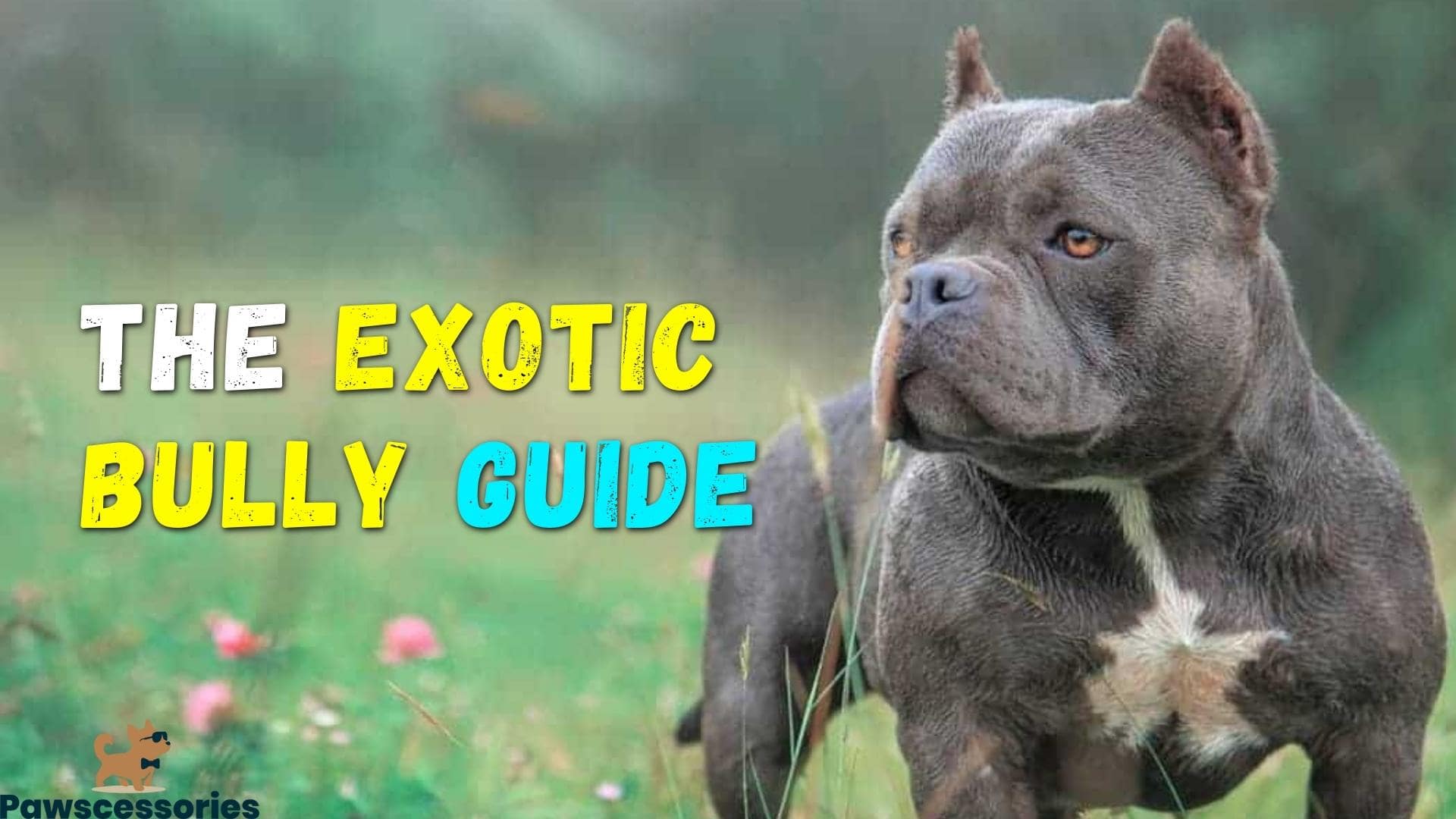
What Is An Exotic Bully?
The exotic bully breed is a new type of Bully that has been developed by crossing several different Bully breeds.
Exotic Bullies have exaggerated bulldog features with small bodies. This makes them appear “exotic” and like a shrunken version of a Bulldog, American Bully, or Pitbull.
The Exotic Bully is still very rare, but their popularity has been slowly growing all over the world.
Starting in 2008, the exotic Bully was first bred and was meant to be a form of the American Bully.
It took roughly five years to achieve the Exotic Bully look, and they eventually became recognized by various kennel clubs as their own individual breed.
However, because these dogs have not yet been classified as AKC or UKC dog breeds, there is no formal Exotic Bully standard.
Some kennel clubs recognize the Exotic Bully, have developed their own Exotic Bully Standard, and regularly hold Exotic Bully dog shows.
Here are a few examples:
- The International Bully Coalition was the first and set the breed standard for them.
- The US Bully Registry (USBR) set a standard for “Clean Exotic Bullies” and started registering Exotic Bullies in 2013.
- The American Bully Register gave recognition to the Exotic Bully as a subtype of the American Bully.
- The International Breed Certificate (IBC) named Exotic Bullies as a new type of American Bully.
Breeders have even come up with their own versions and names for Exotic Bullies.
That’s why you will see other names for them, such as Clean Exotic Bully, the Exotic American Bully, the Micro Exotic Bully, and more.
What Breeds Make An Exotic Bully?

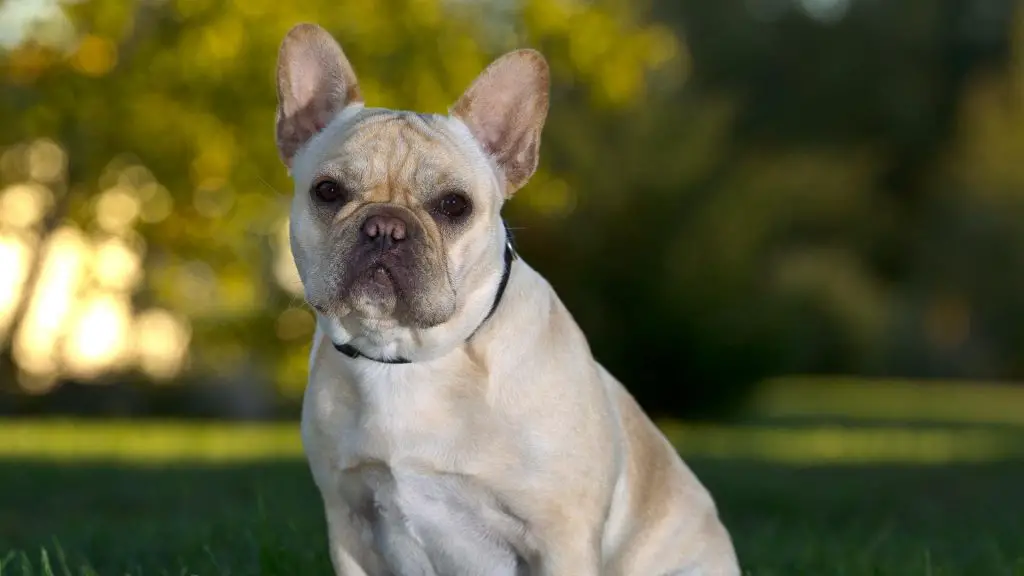
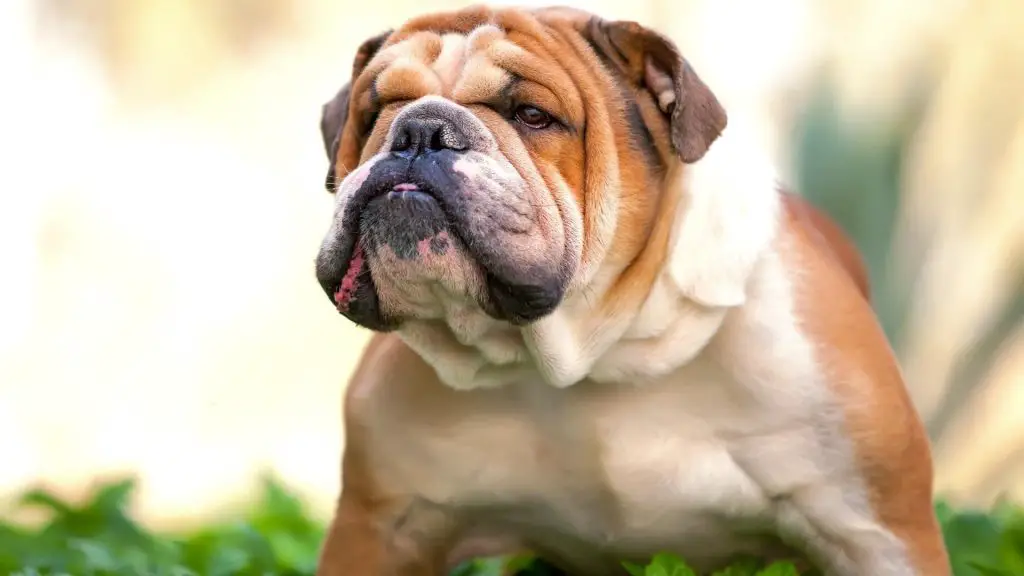
The Exotic Bully carries many traits from various Bulldogs, including the American Bulldog, Olde English Bulldog, English Bulldog, and the French Bulldog.
However, there seem to be many other bulldogs that could have been included as well.
Through the constant breeding among bulldog types, they formulated the Exotic Bully.
So there is no concrete Bully breeds that make up the Exotic.
What Was The Exotic Bully Bred For?
Exotic Bullies were originally bred for companionship and as family pets.
However, because of their unique physical appearance, they are also now often used as show dogs in Exotic Bully dog shows.
Exotic Bully Appearance & Traits
The Exotic Bulldogs were designed to be more compact and muscular while keeping some of the desirable features of Bulldog breeds.
This resulted in the Exotic Bully containing a blocky head, broad chest, short legs, and shorter muzzle compared to the American Bully.
They have the muscle tone and girth of an American Bully but are much smaller and lighter.
Size (Weight & Height)
To determine the size of the Exotic Bully, we must classify them into two categories, the Micro Exotic Bully and the Standard Exotic Bully.
The Micro Exotic Bully is the smaller of the two and typically weighs between 20-35 pounds and is under 13.5 inches tall.
The Standard Exotic Bully, on the other hand, is a bit larger and typically weighs between 35-50 pounds and is between 13.5 – 16.5 inches tall.
Keep in mind that female Exotic Bullies are usually a bit smaller than males.
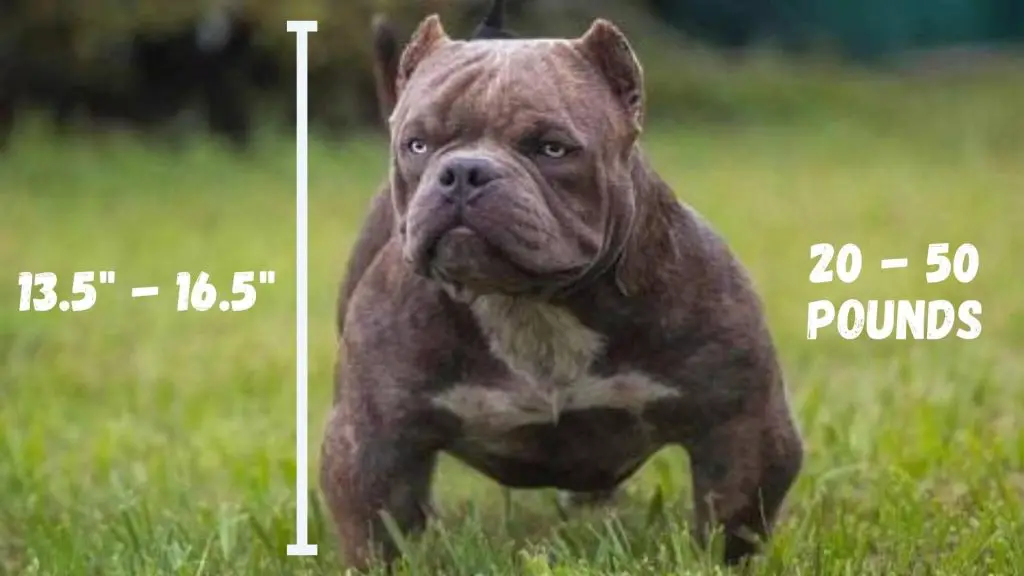
Coat Colors & Texture
The Exotic Bully can come in many different colors and coat textures.
The most popular colors are black, tri-color, blue, brindle, fawn, red, and white.
The Exotic Bully also has a short, stiff coat, and may appear slightly glossy.
Head & Face
The Exotic Bully has a large, square head with a circumference equal to or bigger than their shoulder height.
They have wrinkled faces with short snouts. The Exotic Bully’s eyes come in various colors and are typically round, wide-set, and low down on their face.
Ears & Tail
Exotic Bully ears are rose-shaped, upright, high up, and average size. Some ears may be cropped, and others may be more natural-looking.
An Exotic Bullies tail will be short to medium compared to their size, low set, tapering to a fine point. You may find some with docked tails depending on the breeder.
Lifespan
The Exotic Bully lifespan is roughly 5 to 7 years. However, the micro Exotic Bully lifespan is even lower with some reports saying the average micro Bully lifespan is under five years.
Their low life expectancy is likely due to the health issues that Exotic Bullies have.
In addition, because they are still a relatively new breed, breeders are still trying to rid them of certain health conditions that keep their lifespan low.
For these reasons, how long they live depends on whether they were properly bred.
Unethical breeding methods definitely play a role in why their lifespan is considered so low.
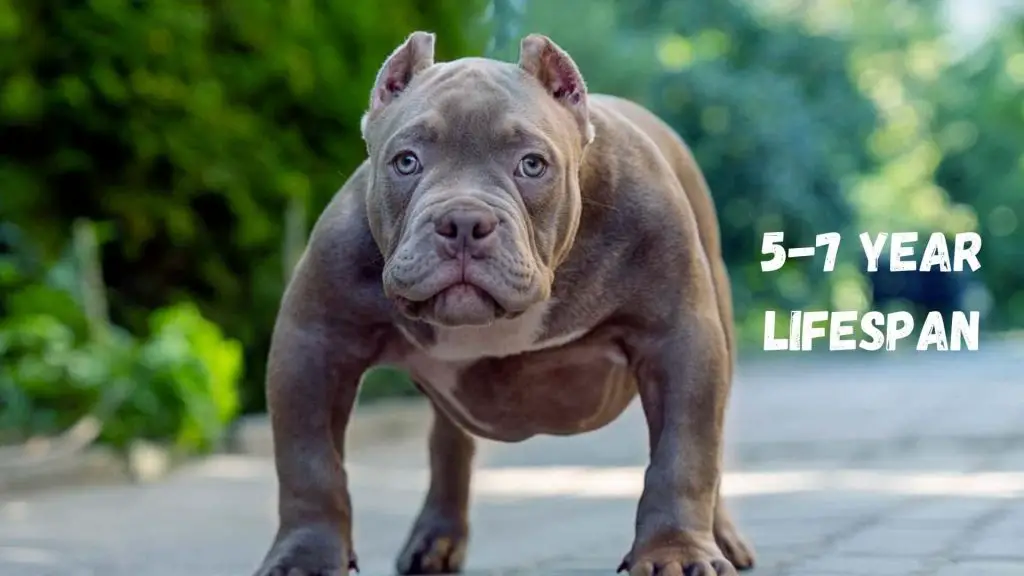
Common Health Issues
As mentioned above, the Exotic Bullies have a relatively low lifespan, and the common health conditions they face do not help.
Some common health problems Exotic Bully will face are:
- Back Problems – When dogs do not have a strong core or back to support their weight, it can lead to back problems. Exotic Bullies are no different and commonly suffer from slipped discs, intervertebral disc disease, etc.
- Brachycephalic – This is a common condition that flat-faced dogs such as Exotic Bullies suffer from. Because they have short snouts, it can cause them to have respiratory problems.
- Eye Problems – Exotic bullies have protruding eyes, making them more susceptible to eye problems and injuries.
- Cardiovascular Disease – Bully breeds are susceptible to many heart issues affecting the valves and interior walls of the heart. Exoctic Bullys carry over these genetic predispositions.
- Hip & Elbow Dysplasia – Exotic Bullies can also suffer from hip and elbow dysplasia which is common in many bully breeds.
- Allergies – Exotic Bullies, like other dogs, can suffer from allergies.
- Skin Problems – Exotic Bullies can also suffer from various skin problems due to their short coats. Eczema, hot spots, and seborrhea are commonly seen in the Bully breeds.
Shedding & Grooming
The Exotic Bully is a moderate shedder and requires little to no grooming.
Because they have short coats, they do not need to be brushed often.
An occasional bath with a mild dog shampoo will suffice.
You should also check their ears regularly for any wax buildup or debris and clean them as needed.
Some Exotic Bullys will hate getting their ears cleaned, so it’s important to familiarize them with touching them from a young age.
And as with all dogs, you should brush their teeth regularly to prevent tartar buildup and gum disease.
Trainability
The Exotic Bully is a relatively smart dog that responds best to positive reinforcement training methods such as treats, praise, and play.
Harsh punishment will only make them shut down and become uncooperative.
It’s important to start training early on with Exotic Bullies as they can be somewhat stubborn.
Dog training should start as soon as they come home with you.
Crate training is also recommended to help with the potty training process and prevent them from getting into mischief when you cannot watch them.
Socialization is also crucial for Exotic Bullies, especially if you often plan to take them out in public.
They should be socialized with people and other animals from a young age to prevent aggression or fearfulness from developing.
They are naturally very social, so this should not be a problem!
Exotic Bullies are not aggressive by nature, but with improper care or training, any dog can become aggressive.
Activity Level & Exercise Needs
The Exotic Bully is a relatively inactive dog that does not require much exercise.
They fall in the category of moderately active. A daily walk or play session in the yard will suffice.
They are not an overly active breed and do not need a ton of exercise to stay happy and healthy.
While they may not need a lot of exercises, Exotic Bullies still need some form of mental stimulation to prevent boredom.
This can be in the form of interactive toys, food puzzles, or even just simple obedience training.
Exotic Bullies are not the best dog breed for someone who is looking for active hiking or running buddy, but they make great couch potatoes!
Intelligence
The Exotic Bully is considered relatively smart and quite obedient when properly trained.
They can be stubborn at times, but with consistency and positive reinforcement training, they will catch on quickly.
Further Reading: You can check out the US Bully Registry information and guidelines on the appearance and traits that classify Exotic Bullies for more details.
Temperament & Behavior
In this section, we will look at the exotic Bully temperament and what makes them so unique, what kind of personality you can expect, and which environments and households they do best in.
Generally, you can expect an Exotic Bully to be social, loving, loyal, and protective.
Thye may look intimidating, but they are very friendly. This is especially true when you properly socialize them with people and other dogs from a young age.
They are not the most active dogs, so they aren’t the best dogs for people living a very active lifestyle. They won’t do well on long hikes or adventures.
Are Exotic Bullies Aggressive?
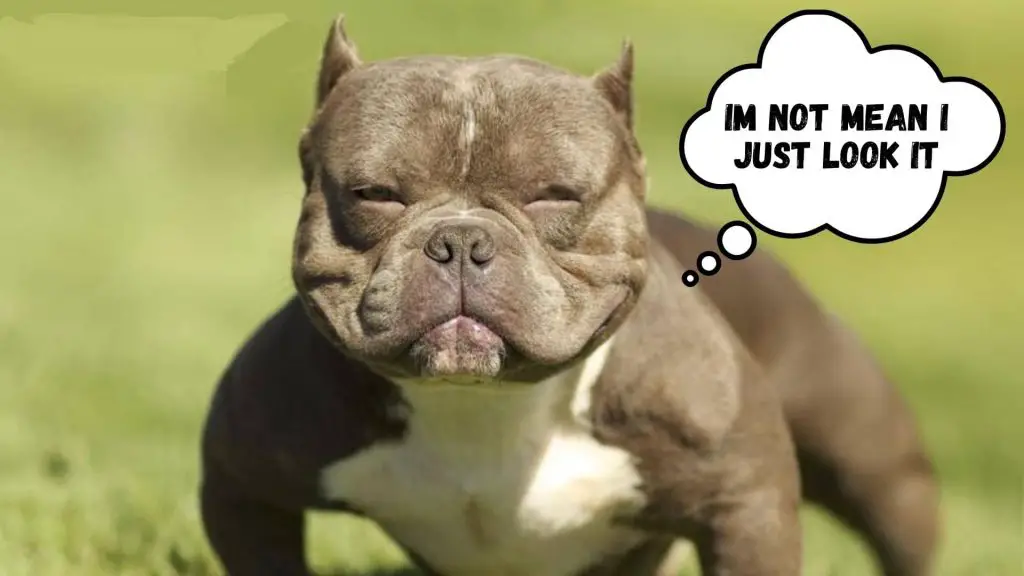
No, Exotic Bullies are not aggressive by nature. However, dogs can become aggressive if they are not adequately cared for or trained.
It’s essential to socialize them from a young age and train them with positive reinforcement methods to prevent aggression from developing.
Many Bully breeds get misrepresented in the media as being aggressive when they are very gentle and loving dogs.
How Are Exotic Bullies With Kids?
They are great with children and make wonderful family pets. Exotic Bullies are very gentle, loving, and protective of their families.
Kids can sometimes be too rough with dogs, and Exotic Bullies are not the best breed for households with very young children who may not know how to treat a dog properly.
If this is the case, a young child should never be left alone unsupervised with any Exotic Bully.
Older kids who know how to treat animals respectfully will do fine with an Exotic Bully in the household.
How Are Exotic Bullies With Other Dogs?
Overall, Exotic Bullies do well with other dogs. They are social creatures by nature and love being around their pack (i.e. their family).
If you have another dog in the household, this will make it much more manageable.
The sooner you start their socialization, the better.
How Are Exotic Bullies With Strangers?
While they may be aloof with strangers at first, they will quickly warm up once they realize there is no threat.
This is likely due to their protective nature toward their family.
So long as you make sure an Exotic Bully is socialized at a young age with new people in various environments, you’ll have no issues.
Are Exotic Bullies Good Apartment Dogs?
Yes, Exotic Bullies do well in apartments or other small living spaces. They are not an overly active breed and only need a moderate amount of exercise.
This makes them the perfect breed for people who live in apartments or work long hours and can’t provide their dogs with much exercise.
Now with that said, they still require lots of mental stimulation and training.
So you may be able to get away with walking them every other day, but they will still need your attention and care.
Daily obedience training is highly recommended and can be the mental stimulation they need.
Food & Diet

So, now that we know what an Exotic Bully is like, what do you feed them?
Depending on their age, their portions and food contents will change.
What you feed an Exotic Bully Puppy will be puppy foods that contain lots of protein and fat.
You want to look for ones with at least 30% protein and at minimum 20% fat.
The higher the quality of the food, the better.
As they get older, their portions will change, the amount of food they eat will increase, and they will slowly switch over to adult food at around one year old.
They will do fine on most high-quality dog foods. However, Exotic Bullies are prone to obesity, so you’ll want to be careful not to overfeed them.
My father, Dr. Littlejohn, recommended 1 of 4 dog food brands for the highest quality foods.
How Much Are Exotic Bullies Worth?
As this breed continues to grow in popularity, prices have seemed to skyrocket.
From an ethical breeder with a good bloodline of these dogs, Exotic Bully Puppies can cost roughly $3,000 to $7,000.
In some places, breeders charge up to $40,000 for Exotic Bullies with rare colors.
Since Exotic Bullies are still a relatively new breed, not many of them exist.
And since there is a high demand for them, breeders can charge high prices.
Where Can You Buy An Exotic Bully?
If you’re looking for an Exotic Bully near you, there are a couple of places you can look.
- NWG Bullies – This breeder has been producing high-quality canines for the past ten years. They provide each puppy with a health guarantee and a purchase contract, which is essential if you want to acquire a healthy Exotic Bully. Their dogs are registered with the American bully kennel club and some other bully clubs.
- Toadline Exotic Bully – They have full documents, a health certificate, and a 7-day health warranty. They also provide a satisfaction guarantee, allowing you to return your puppy if you are unhappy with your purchase.
- Venom Line – They are recognized for breeding Bullies in excellent physical condition. They will give you a contract, registration papers, and most importantly, a health certificate from a licensed veterinarian.
- Blue Legacy Exotic Bullies – This is a breeder to checkout for those looking for Exotic Bully puppies for sale in California.
Aside from those breeders, you can also look to adopt a Bully from
Adoption fees usually cost around $150 and can go up to $400 depending on the dog’s age.
How Is The Exotic Bully Different From Other Bully Varieties?
The Exotic Bully is a new type of Bully that has been developed by crossing several bully breeds.
But how can you tell the difference between all these bully dog breeds?
Let’s compare a few to see how other Bully breeds compare to the Exotic.
Exotic Bully Vs. American Bully
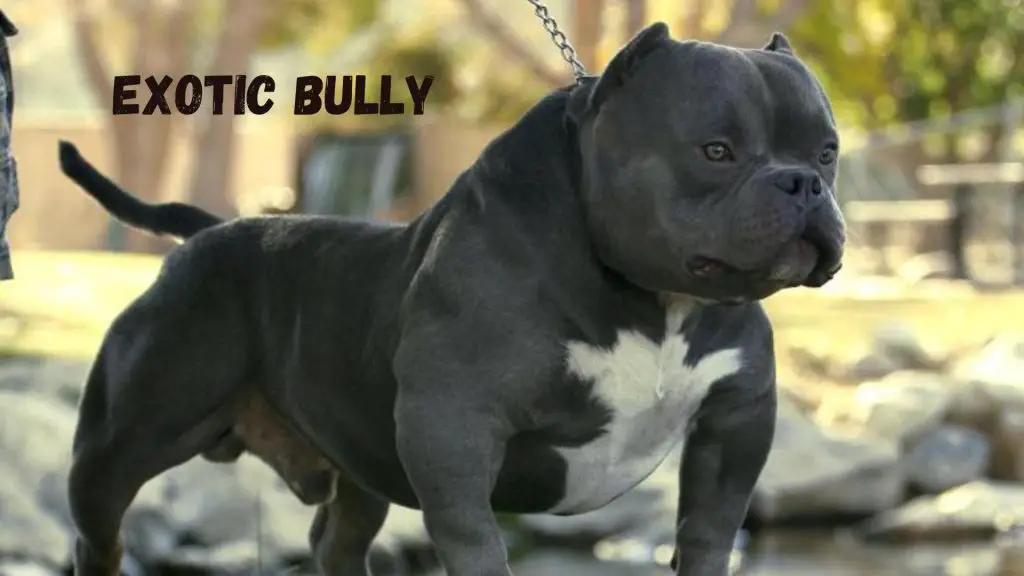
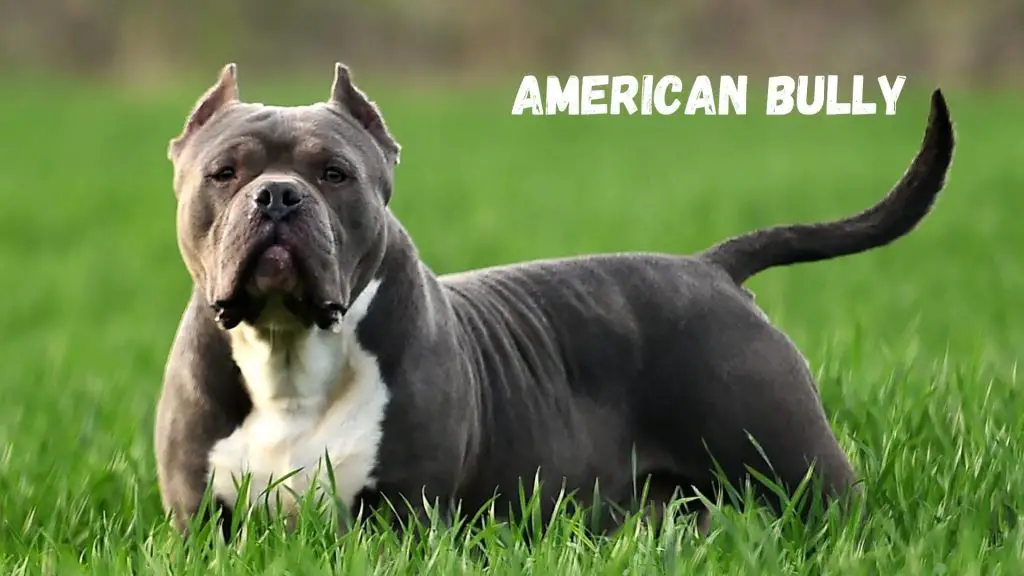
The Exotic Bully can easily be mistaken for the American Bully because they are similar in many ways.
The Exotic Bully is a sub-type of the American Bully, so it shares many of the same features.
The biggest difference between these two bully breeds is their size.
Exotic Bullies are smaller than American Bullies and usually don’t weigh more than 30 pounds.
American Bullies, on the other hand, can weigh up to 100 pounds.
Another difference is that Exotic Bullies have shorter coats than American Bullies.
And lastly, Exotic Bullies tend to have more exaggerated features than American Bullies.
Exotic Bully Vs. Pocket Bully
The Exotic Bully is often confused with the Pocket Bully because they are similar in size and appearance.
However, there are a few key differences between these two bully breeds.
For one, the Pocket Bully is bred with the American Bully and Patterdale Terrier. In contrast, the Exotic Bully is bred with the American Bully and a few other bulldog breeds.
The Exotic Bully usually contains a mix of Bully breeds.
This difference means that although they are similar, they have genetic differences that change their appearance and behavioral traits.
The Pocket Bully is only 11-22 pounds, whereas the Exotic Bully can be 30-50 pounds.
However, both are very similar in height, so the stocky thickness of the Exotic is the big giveaway when looking at them.
Not to mention the Exotic Bully has a much broader and squished-looking face.
Other Frequently Asked Questions
What Is A Clean Exotic Bully?

Clean Exotic Bully dogs have fewer health problems and don’t carry any of the known physical issues these dogs can have.
A Clean Exotic Bully describes Exotic Bullies that come from healthier lines and have been bred responsibly.
They are essentially “cleaner” versions genetically.
Some common issues some Exotic Bullies have that the Clean Exotic Bully does not have are:
- Weak lower jaw
- Curly hair
- Snippy muzzle
- Sloped skull
- Unproportioned body
The list goes on, and you can find the full one on the US Bully Registry website.
What Is A Micro Exotic Bully?
A Micro Exotic Bully is simply an Exotic Bully that falls on the smaller side of the weight spectrum.
They usually weigh 20-35 pounds and are under 13.5 inches tall.
They are sometimes also referred to as “Mini Exotics.”
What Is A Exotic Pocket Bully?
An Exotic Pocket Bully is just another name for the Micro Exotic Bully that some breeders have decided to call them.
They fall on the smaller side of the weight spectrum, usually 20-35 pounds and under 13 inches tall.
What Is An Exotic American Bully?
The International Bully Register (IBR) named their exotic class of bullies American Bully Exotics.
So the Exotic American Bully is just another name for the Exotic Bully that IBR breeders decided to name them.
Final thoughts
The Exotic Bully is a beautiful, unique dog quickly gaining popularity.
They are smaller than most bully breeds and have shorter coats.
Their exaggerated features make them stand out from the crowd, and their friendly temperament makes them great family pets.
If you’re looking for an Exotic Bully of your own, be sure to do your research and find a reputable breeder.
Other posts you might find interesting:
Pocket Pitbull (AKA The Mini Pitbull): All You Need To Know
